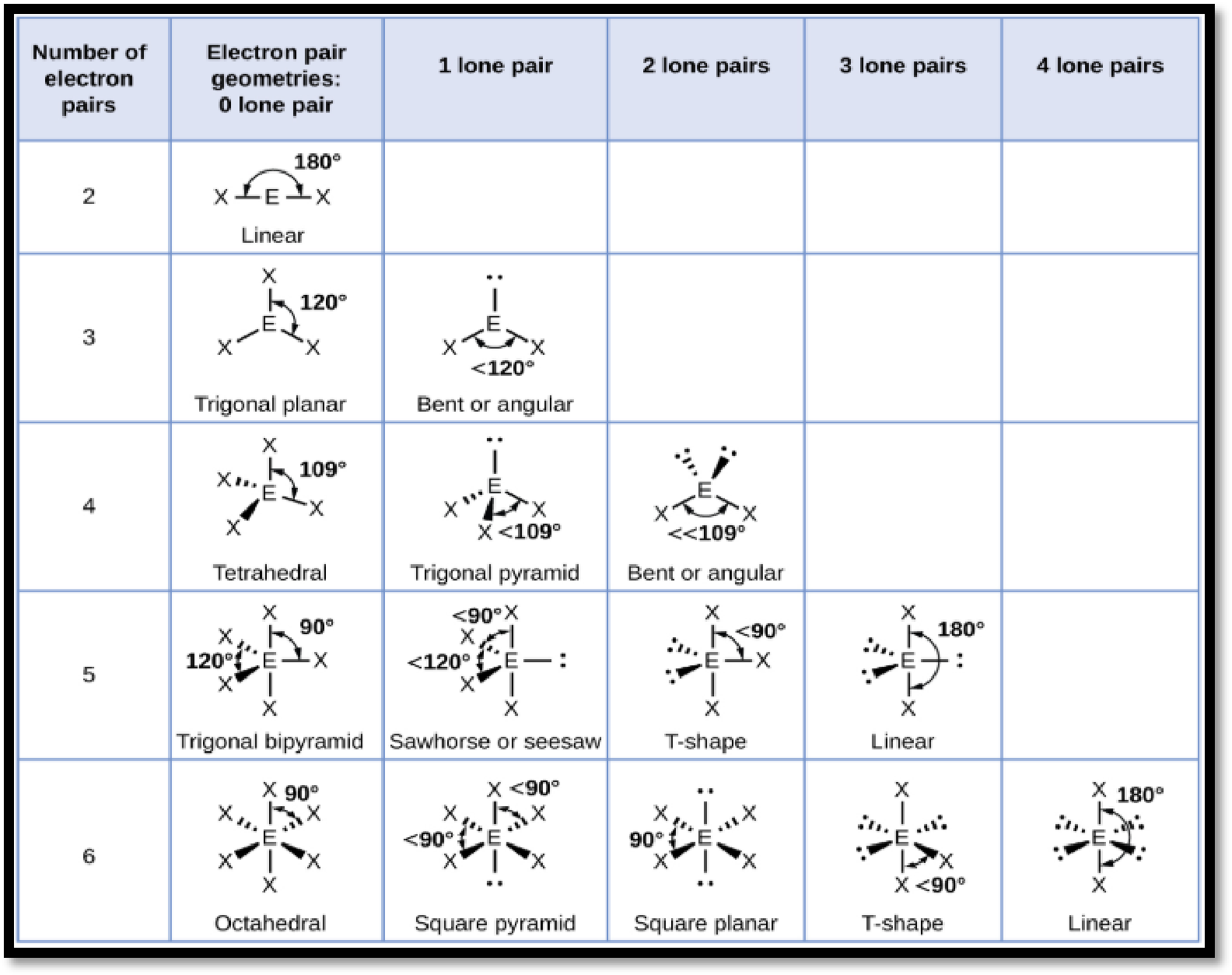
(a)
Interpretation:
From the given depiction, which shows the shapes of the reactants and product has to be given.
Concept Introduction:
Valence shell electron pair repulsion (VSEPR) theory:
The geometry of molecule is predicted by valence shell electron pair repulsion (VSEPR) theory, this theory state that the repulsion force between lone pair and bond pair electrons of central atom is given by,
Lone pair-lone pair > lone pair - bond pair > bond pair - bond pair
From the order of repulsion forces and number of lone pair electrons, bond pair electrons that are present in the central atom, the geometry of molecule is assigned in the below manner,

Figure 1
(c)
Interpretation:
The changes in hybridization of xenon in given reaction has to be given.
Concept Introduction:
Hybridization:
The formation of new orbitals from the mixing of atomic orbitals is known as hybridization.
In hybridization, energy and count of newly formed orbital is same as the atomic orbitals.
Overlapping of atomic orbitals are formed new hybridized molecular orbitals.
Want to see the full answer?
Check out a sample textbook solution
Chapter 14 Solutions
Chemistry: The Molecular Nature of Matter and Change (Looseleaf)
- Q6: Monochlorination of methylcyclopentane can result in several products. When the chlorination occurs at the C2 position, how many stereoisomers are formed? If more than one is formed, are they generated in equal or unequal amounts? 2arrow_forwardShow work. Don't give Ai generated solutionarrow_forwardPlease correct answer and don't use hand ratingarrow_forward
- Q: Draw the molecular orbital energy level diagram for the following molecules. 1- The SF4 molecule is seesaw molecular geometry and has C2v point group. 2- The Mn(CO)s molecule with C4v point group is square pyramidal.arrow_forwardPlease correct answer and don't use hand ratingarrow_forwardwhen a 0.150 g sample of the compound was burned, it produced 0.138 g CO2 & 0.0566 g H2O. All the nitrogen in a different 0.200 g sample of the compound was converted to NH3, which was found to weigh 0.0238 g. Finally, the chlorine in a 0.125 g sample of the compound was converted to Cl- and by reacting it with AgNO3, all of the chlorine was recovered as the solid AgCl. The AgCl, when dried was found to weigh 0.251 g. What is the empirical formulaarrow_forward
 ChemistryChemistryISBN:9781305957404Author:Steven S. Zumdahl, Susan A. Zumdahl, Donald J. DeCostePublisher:Cengage Learning
ChemistryChemistryISBN:9781305957404Author:Steven S. Zumdahl, Susan A. Zumdahl, Donald J. DeCostePublisher:Cengage Learning ChemistryChemistryISBN:9781259911156Author:Raymond Chang Dr., Jason Overby ProfessorPublisher:McGraw-Hill Education
ChemistryChemistryISBN:9781259911156Author:Raymond Chang Dr., Jason Overby ProfessorPublisher:McGraw-Hill Education Principles of Instrumental AnalysisChemistryISBN:9781305577213Author:Douglas A. Skoog, F. James Holler, Stanley R. CrouchPublisher:Cengage Learning
Principles of Instrumental AnalysisChemistryISBN:9781305577213Author:Douglas A. Skoog, F. James Holler, Stanley R. CrouchPublisher:Cengage Learning Organic ChemistryChemistryISBN:9780078021558Author:Janice Gorzynski Smith Dr.Publisher:McGraw-Hill Education
Organic ChemistryChemistryISBN:9780078021558Author:Janice Gorzynski Smith Dr.Publisher:McGraw-Hill Education Chemistry: Principles and ReactionsChemistryISBN:9781305079373Author:William L. Masterton, Cecile N. HurleyPublisher:Cengage Learning
Chemistry: Principles and ReactionsChemistryISBN:9781305079373Author:William L. Masterton, Cecile N. HurleyPublisher:Cengage Learning Elementary Principles of Chemical Processes, Bind...ChemistryISBN:9781118431221Author:Richard M. Felder, Ronald W. Rousseau, Lisa G. BullardPublisher:WILEY
Elementary Principles of Chemical Processes, Bind...ChemistryISBN:9781118431221Author:Richard M. Felder, Ronald W. Rousseau, Lisa G. BullardPublisher:WILEY





